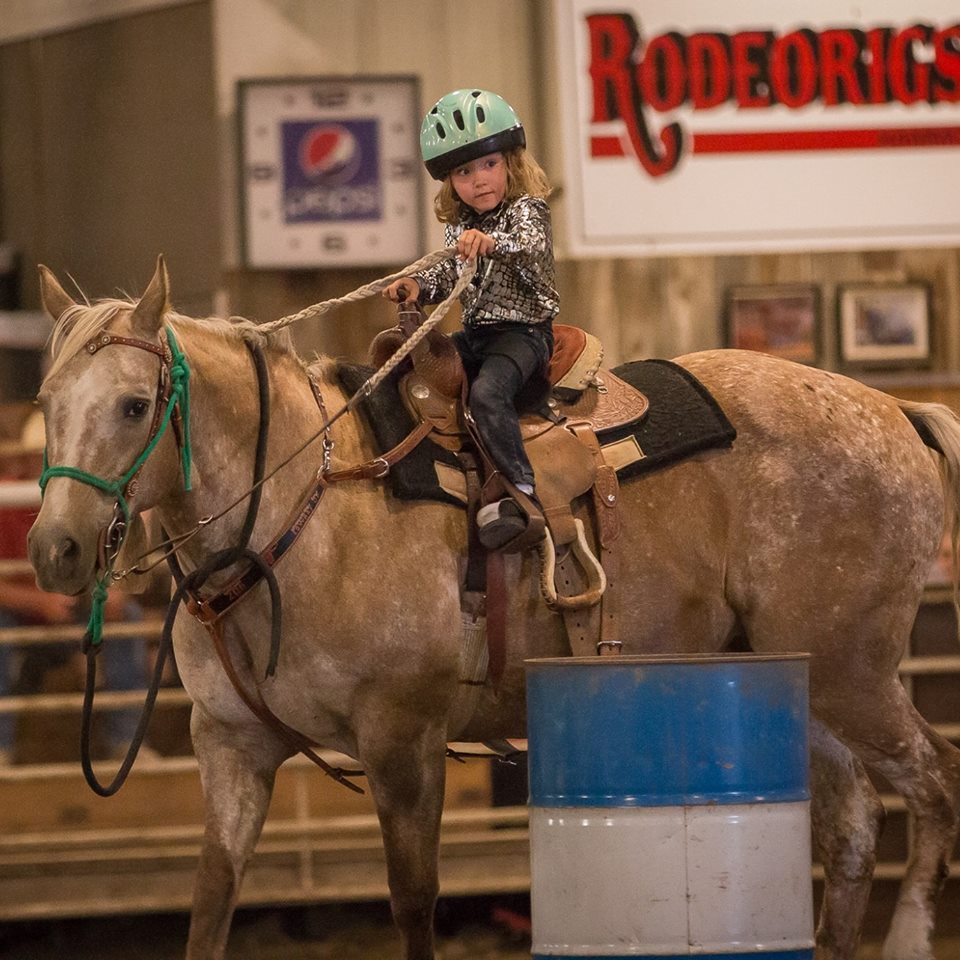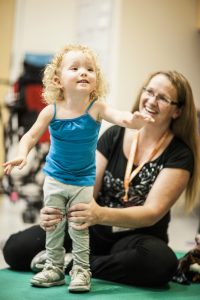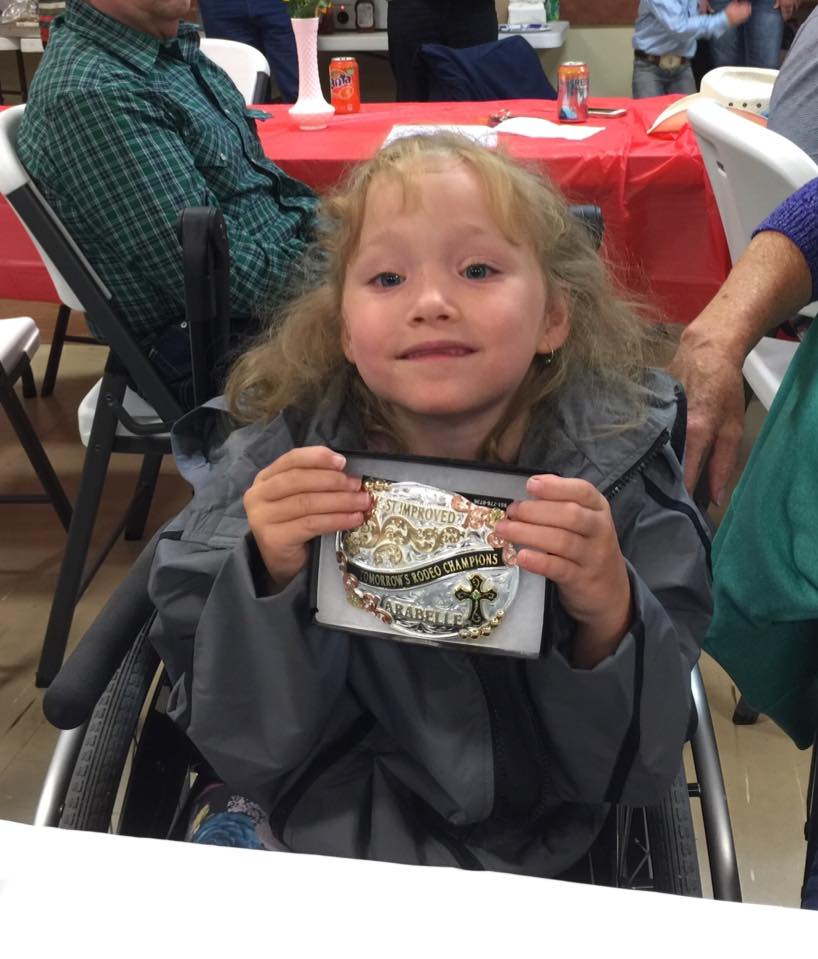On Thursday nights this summer, 7-year-old Arabelle Laddusaw is saddling up alongside other children and teens to compete in the Tomorrow’s Rodeo Champions’ summer rodeo series in her hometown of Billings, Montana. As she sits up straight and grips the reins of her horse in anticipation of the chute opening, her cerebral palsy is the last thing slowing down the thrill of events such as barrel racing, pole bending and the crowd favorite, goat tail tying.
However, the prospect of being able to sit naturally on a horse wasn’t always a future possibility for Arabelle who was diagnosed at birth with cerebral palsy, a neurological condition that affects muscle movement and limits mobility.
As a toddler, the muscles in Arabelle’s legs were so tightly wound they would scissor – one leg twisting over the other – making it difficult for her to stand upright or simply straighten her legs out in front of her when sitting.
“With her, it was challenging because she required constant assistance,” said Arabelle’s mother, Christine Laddusaw. “She wasn’t just a normal child that you could put down and let play.”
Surgery to gain mobility

Arabelle first began working with Dr. Susan Apkon, director of Rehabilitation Medicine and a specialist in the care of children with cerebral palsy, through a Seattle Children’s outreach clinic at affiliate St. Vincent Healthcare in Billings. It was Apkon who suggested Arabelle may benefit from selective dorsal rhizotomy (SDR), a neurosurgery performed on the lower spinal cord to decrease muscle spasticity or stiffness.
“Arabelle is always determined, sometimes to the point of being stubborn, to do the activities other kids her age are doing,” said Laddusaw. “I wanted to do everything possible to give her the best opportunity to do all the things she was determined to do. We came to Seattle Children’s to see if SDR would be a good option for us.”
During an extensive evaluation, Laddusaw discussed the goals she hoped SDR would help Arabelle achieve.
“We talked about how SDR could give her more control over her body so that she could walk better with her walker, sit up straighter and do more typical kid things,” said Laddusaw. “Her older siblings were all into rodeo, so I wasn’t surprised that she wanted to ride horses too.”
A way to permanently improve muscle control
Neurosurgeon Dr. Samuel Browd agreed that Arabelle would find improvement with SDR and successfully completed her procedure at Seattle Children’s when she was 3 years old. By carefully selecting and cutting the sensory nerves responsible for the stiff muscle tone, SDR can permanently improve muscle control in children with cerebral palsy.
“During the surgery, we’ll perform 80 to 100 individual electrical stimulations, testing each sensory nerve,” said Browd. “With my surgical team of rehabilitation medicine and neurophysiology specialists, we’ll go one by one to determine whether a nerve is normal or abnormal.”
“If it’s responding normally, we preserve that nerve root. If it gives an abnormal response to the stimulation, we then consider what muscle groups are involved and whether those muscles are directly impacting the child’s function. If so, we then decide how much of that nerve root should be sectioned or cut. This technique allows us to tailor our surgery to that individual’s needs.”

Three days post-surgery, Arabelle began an intensive inpatient rehabilitation therapy program, a critical and unique feature of the program at Seattle Children’s, focused on helping her build strength and learn to use each of her muscles independently before returning home to Montana.
Getting in the saddle
Since the SDR surgery and rehabilitation, Arabelle has continued to see Apkon for follow-up care in Billings. She receives a phenol injection to help manage tone approximately every six months.
“While SDR will reduce tone, the child will still have cerebral palsy,” said Apkon. “Kids like Arabelle will continue to require therapy services after SDR to advance their motor skills. Part of my role as a rehab physician is to work with kids and families to provide various treatments relevant to the ongoing care of their cerebral palsy based on their age, functional level and goals.”
Despite some underlying orthopedic issues, Arabelle keeps making steady progress.
“Her progress has been amazing,” said Laddusaw. “I am pleased that the SDR surgery, ongoing therapy and injections, have all contributed to her legs being much looser whether she’s walking or riding a horse. I don’t think there’s any way she would be able to sit in the saddle if her legs were still scissoring.”
One confident cowgirl

With each summer rodeo this season, Arabelle is improving on her times. One of her favorite events is goat tail tying. Each participant must ride to a goat, dismount their horse and tie their ribbon around the goat’s tail. In another event, the ribbon flag race, Arabelle places and retrieves flags on barrels while riding her horse. Both require skill, coordination and muscle control to post as fast of a time as possible.
“While she’s participated in the rodeos over the last couple of summers, this is the first year she’s learned the barrel patterns and is leading the horse in the arena all on her own,” said Laddusaw. “Competing has provided Arabelle independence, friendship and is a big confidence builder, especially when the older kids come up and tell her good job after an event.”
At last year’s awards banquet, Arabelle won the buckle for most improved.
“When Christine showed me a video of Arabelle practicing on her horse, I couldn’t believe it. It was wonderful,” said Apkon. “What I want most for the kids and families I work with is for them to be active in their community. It’s a huge success knowing that Arabelle is able to participate in an activity that is important to her and such a staple of growing up in Billings.”
For more information about selective dorsal rhizotomy, please contact Seattle Children’s Tone Management Program at 206-987-5917.
Resources
- Learn more about selective dorsal rhizotomy (SDR)
- Cerebral Palsy Procedure Helps 4-Year-Old Take His First Steps
- Seattle Children’s Neurosciences Center
- Seattle Children’s Rehabilitation Medicine
- Cerebral palsy and spasticity treatment

